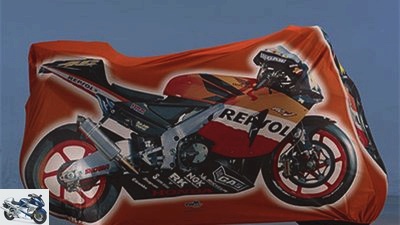Table of contents
- Advice on motorcycle tarpaulins Under the hood
- Advice mothballing – mothballing: this is how it’s done

fact
accesories
Advice on motorcycle tarpaulins
Advice on motorcycle tarpaulins
Under the hood
Garage spaces are rare in many places. This is why machines often come under the hood, especially in the winter months. MOTORRAD shows how they survive longer undercover campaigns.
Uli Holzwarth
11/03/2004
Life on the street is tough. Rain, snow, dust or UV radiation cause the machine parked on the roadside to age in fast motion. It’s nice to have a dry garage. But these are in short supply, especially in the big cities. And then often only a tarpaulin is left to protect the bike from the weather. Almost all suppliers of motorcycle accessories have them in their range. There is no shortage of choice, with prices ranging from around five euros for simple PVC throws to lined luxury specimens that cost more than 100 euros.
Buy complete article

advice
Cover tarpaulins / mothball the motorcycle
4 pages) as PDF
€ 2.00
Buy now
Although lantern parkers do not necessarily have to resort to the most expensive variant, only a stable cover in a heavy and absolutely watertight design is possible for two-wheelers parked permanently outdoors. Such specimens can usually be recognized by the incorporated fabric structure, which gives the tarpaulin a high level of tear resistance. Other useful equipment details are a paint-friendly fleece coating on the inside as well as at least four stable lashing eyes to fix the tarpaulin to the motorcycle with elastic bands or straps in stormy weather. Ideally, two of these eyelets are large enough for a chain lock to fit through to protect the tarpaulin from theft. Another practical feature is a viewing window at the rear that makes it easier for the police to check the number plate. Deregistered bikes may not be parked in the public traffic area.
When it comes to the correct size of a tarpaulin, one should not proceed according to the motto “a lot helps a lot”. A specimen chosen too far flutters more or less violently in the wind and can damage or even tear off exposed vehicle parts such as windshields, mirrors and indicators. It is therefore important that the tarpaulin is relatively tight on the motorcycle (if necessary, use tensioning straps to help) and, if possible, not all the way to the ground to ensure a minimum of ventilation. This is the only way to avoid excessive condensation in the event of temperature fluctuations. On sunny days you should remove the hood anyway, so that no moisture can settle anywhere and the rust blooms in spring.
Before the motorcycle disappears under a tarpaulin for weeks, it should be cleaned thoroughly beforehand. The fluttering cape can have an effect similar to sandpaper on heavily soiled surfaces.
The use of a tarpaulin on freshly painted vehicles is taboo because the solvents contained in the paint still evaporate a few months afterwards and can damage both the overcoat and vehicle parts, especially those made of plastic. caution
is also appropriate when using preservation sprays. In the worst case, chemical reactions with the plastic cover can occur. Frequent checks are therefore advisable.
On the other hand, the use of dust protection tarpaulins in indoor areas is much less problematic. However, it should be an air-permeable specimen because temperature fluctuations occur even in closed rooms. Corrosion-promoting condensation water can therefore develop under waterproof plastic tarpaulin even in a garage.
If you want to be on the safe side during the winter, you should properly mothball your motorcycle beforehand – before the motorcycle comes under the hood.
Advice mothballing – mothballing: this is how it’s done
With modern motorcycles, the preparatory work for wintering is kept within manageable limits. However, a few steps are essential so that there are no nasty surprises in spring.
The first thing to do is to thoroughly clean the machine. Dirt magically attracts moisture and acts as a breeding ground for corrosion during the winter months. Gentle hand washing with a sponge and brush is best. A positive side effect: minor paint damage can be recognized very easily with this type of cleaning and can be repaired immediately before ugly rust pimples form. Then dry the motorcycle well, not forgetting hidden corners. Long journeys on dry roads are also suitable as a »hair dryer«.
If the oil is up to operating temperature, you can also do the necessary change including the oil filter. After that, the engine should stop running if possible. Incidentally, you can save yourself the need to add oil through the candle hole with modern aluminum engines.
Now comes the most important step for motorcycles with carburettors: All float chambers must be completely emptied because deposits can form in the nozzle assemblies after a short period of time, which can only be removed with an extensive cleaning next spring.
For motorcycles with aluminum or plastic tanks, it is best to completely drain the fuel, while unsealed sheet steel tanks are filled up to the upper edge of the filler neck.
Then lubricate the chain, the tire air pressure by 0.5 bar
increase, treat bare metal surfaces with a preservative spray and check the antifreeze protection on water-cooled engines. Finally, remove the battery, charge it and store it in a dry and frost-free place. Jack up the machine so that both wheels are unloaded.
Related articles
-
Buying advice for cars for motorcycle transport
archive 23 pictures archive 1/23 Although the motorcycle could also be dragged into this family carriage, it is also more convenient: We are presenting…
-
Motorcycle helmet purchase advice: What to look out for when buying a helmet
MIPS 10 pictures MIPS 1/10 Researchers and studies have linked severe brain injuries, as well as minor injuries such as concussions, to rotational…
-
Product test: motorcycle tarpaulins
mps photo studio accesories Product test: motorcycle tarpaulins Product test Motorcycle tarpaulins This is what it looks like when MOTORRAD editors dig…
-
Motorcycle helmets: test, purchase advice, ECE standard, communication
Herder 14th pictures Herder 1/14 Jorg Lohse trying in vain to mount a wind deflector on the X-lite. Can you test harder? no! Herder 2/14 The Schuberth S1…
-
Purchase advice 14 motorcycle soft luggage bags
mps photo studio 28 pictures Dentges 1/28 For this comparison of panniers, MOTORRAD has put together representative equipment for a weekend tour. mps…
-
17 motorcycle tarpaulins (indoor & outdoor) in the product test
Klaus Herder 26th pictures Klaus Herder 1/26 A total of 17 tarpaulins competed against each other in a comparative test in two disciplines. The first…
-
Safe through the motorcycle season
oneinchpunch – Fotolia counselor Safe through the motorcycle season advertisement Insure a motorcycle Safe through the motorcycle season The weather is…
-
Screwdriver tips for motorcycle seats
Ralf Petersen 13th pictures Ralf Petersen 1/13 Ralf Petersen 2/13 Ralf Petersen 3/13 Ralf Petersen 4/13 Ralf Petersen 5/13 Ralf Petersen 6/13 Ralf…
-
Falling over or accident – accidental damage to the motorcycle
KTM motorcycles Falling over or accident – accidental damage to the motorcycle Falling over or accident – accidental damage to the motorcycle Gone…
-
Report: Out and about with motorcycle buyers
Dentges counselor Used purchase Report: Out and about with motorcycle buyers Report: Out and about with motorcycle buyers The professionals give tips on…